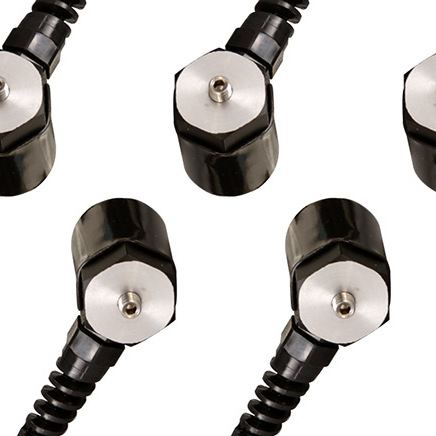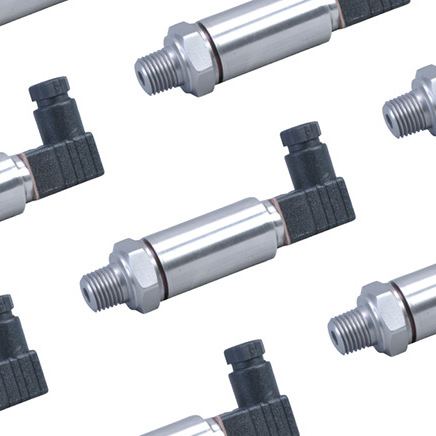A load cell (or loadcell) is a transducer which converts force into a measurable electrical output. Although there are many varieties of force sensors, strain gauge load cells are the most commonly used type.
Except for certain laboratories where precision mechanical balances are still used, strain gauge load cells dominate the weighing industry. Pneumatic load cells are sometimes used where intrinsic safety and hygiene are desired, and hydraulic load cells are considered in remote locations, as they do not require a power supply. Strain gauge load cells offer accuracies from within 0.03% to 0.25% full scale and are suitable for almost all industrial applications.
How does a load cell work?
A load cell works by converting mechanical force into digital values that the user can read and record. The inner working of a load cell differs based on the load cell that you choose. There are hydraulic load cells, pneumatic load cells, and strain gauge load cells. Strain gauge load sensors are the most commonly used among the three. Strain gauge load cells contain strain gauges within them that send up voltage irregularities when under load. The degree of voltage change is covered to digital reading as weight.When to use a load cell?
A load cell measures mechanical force, mainly the weight of objects. Today, almost all electronic weighing scales use load cells for the measurement of weight. They are widely used because of the accuracy with which they can measure the weight. Load cells find their application in a variety of fields that demand accuracy and precision. There are different classes to load cells, class A, class B, class C & Class D, and with each class, there is a change in both accuracy and capacity.
Load Cell Types
Load cell designs can be distinguished according to the type of output signal generated (pneumatic, hydraulic, electric) or according to the way they detect weight (bending, shear, compression, tension, etc.)Hydraulic load cells
 Miniature load cell
Hydraulic cells are force -balance devices, measuring weight as a change in pressure of the internal filling fluid. In a rolling diaphragm type hydraulic force sensors, a load or force acting on a loading head is transferred to a piston that in turn compresses a filling fluid confined within an elastomeric diaphragm chamber.
Miniature load cell
Hydraulic cells are force -balance devices, measuring weight as a change in pressure of the internal filling fluid. In a rolling diaphragm type hydraulic force sensors, a load or force acting on a loading head is transferred to a piston that in turn compresses a filling fluid confined within an elastomeric diaphragm chamber.
As force increases, the pressure of the hydraulic fluid rises. This pressure can be locally indicated or transmitted for remote indication or control. Output is linear and relatively unaffected by the amount of the filling fluid or by its temperature.
If the load cells have been properly installed and calibrated, accuracy can be within 0.25% full scale or better, acceptable for most process weighing applications. Because this sensor has no electric components, it is ideal for use in hazardous areas.
Typical hydraulic load cell applications include tank, bin, and hopper weighing. For maximum accuracy, the weight of the tank should be obtained by locating one force sensor at each point of support and summing their outputs.
Pneumatic load cells
Pneumatic load cells also operate on the force-balance principle. These devices use multiple dampener chambers to provide higher accuracy than can a hydraulic device. In some designs, the first dampener chamber is used as a tare weight chamber.Pneumatic load cells are often used to measure relatively small weights in industries where cleanliness and safety are of prime concern.
 Miniature load cell
Miniature load cell
The advantages of this type of load cell include their being inherently explosion proof and insensitive to temperature variations. Additionally, they contain no fluids that might contaminate the process if the diaphragm ruptures. Disadvantages include relatively slow speed of response and the need for clean, dry, regulated air or nitrogen.
Strain-gauge load cell
Strain gauge load cells are a type of load cell where a strain gauge assembly is positioned inside the load cell housing to convert the load acting on them into electrical signals. The weight on the load cell is measured by the voltage fluctuation caused in the strain gauge when it undergoes deformation.The gauges themselves are bonded onto a beam or structural member that deforms when weight is applied. Modern load cells have 4 strain gauges installed within them to increase the measurement accuracy. Two of the gauges are usually in tension, and two in compression, and are wired with compensation adjustments.
When there is no load on the load cell, the resistances of each strain gauge will be the same. However, when under load, the resistance of the strain gauge varies, causing a change in output voltage. The change in output voltage is measured and converted into readable values using a digital meter.
Piezoresistive load cell
Similar in operation to strain gauges, piezoresistive force sensors generate a high level output signal, making them ideal for simple weighing systems because they can be connected directly to a readout meter. The availability of low cost linear amplifiers has diminished this advantage, however. An added drawback of piezoresistive devices is their nonlinear output.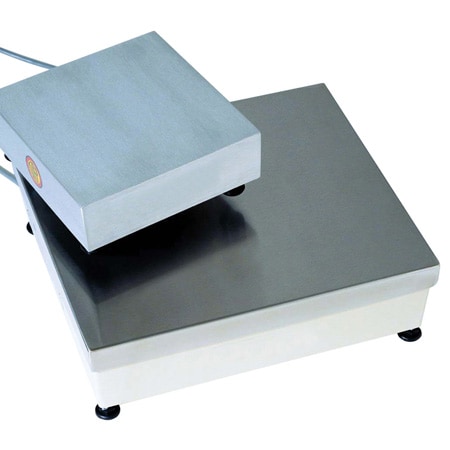 Miniature load cell
Miniature load cell
Inductive and reluctance load cells
Both of these devices respond to the weight-proportional displacement of a ferromagnetic core. One changes the inductance of a solenoid coil due to the movement of its iron core; the other changes the reluctance of a very small air gap.Magnetostrictive load cells
The operation of this force sensor is based on the change in permeability of ferromagnetic materials under applied stress. It is built from a stack of laminations forming a load-bearing column around a set of primary and secondary transformer windings. When a force is applied, the stresses cause distortions in the flux pattern, generating an output signal proportional to the applied load. This is a rugged sensor and continues to be used for force and weight measurement in rolling mills and strip mills.Weighing load cell applications
Load cells represented the first major design change in weighing technology. In today's processing plants, electronic force sensors are preferred in most applications, although mechanical lever scales are still used if the operation is manual and the operating and maintenance personnel prefer their simplicity.In this page you find a weighing system design with load cells.

Choose the right load cell for your application

Compression Load Cells
A compression load cells will often have an integral button design. They are ideal for mounting where space is restricted. They offer excellent long term stability.
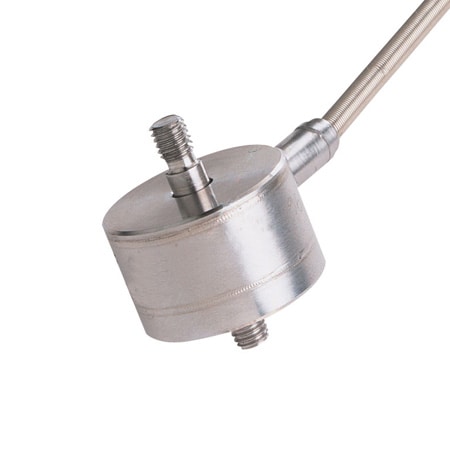
Compression/Tension Load Cells
Compression/tension load cells can be used for applications where the load may go from tension to compression and vice versa. They are ideal for space restricted environments. Threaded ends facilitate easy installation.
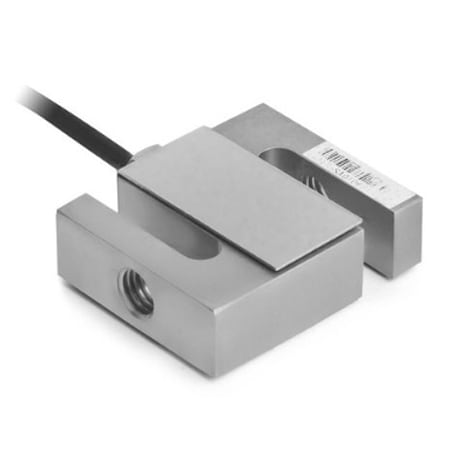
S-Beam Load Cells
A S-Beam load cell get its name from its S shape. S-Beam force sensors can provide an output if under tension or compression. Applications include tank level, hoppers and truck scales. They provide superior side load rejection.
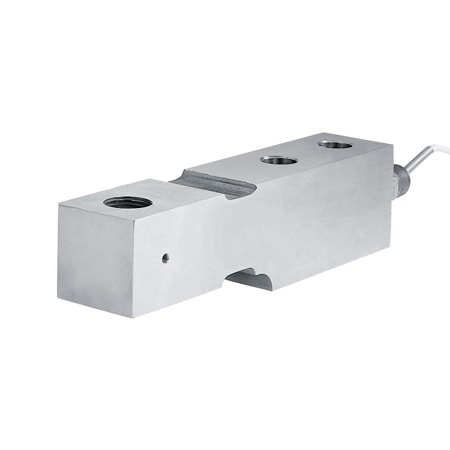
Bending Beam Load Cells
A Bending beam load cell can be used in multiple force applications, tank weighing and industrial process control. It features low profile construction for integration into restricted areas.
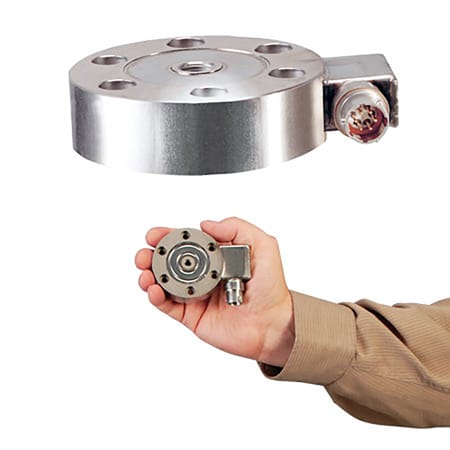
Platform and Single Point force sensors
Platform and single point force sensors are used to commercial and industrial weighing systems. They provide accurate readings regardless of the position of the load on the platform.
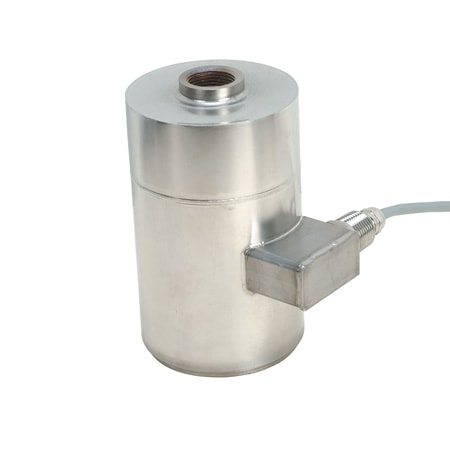
Canister Load Cells
Canister load cells are used for single and multi-weighing applications. Many feature an all stainless steel design and are hermetically sealed for washdown and wet areas.

Origin of the load cell
Before strain gauge based force sensors became the method of choice for industrial weighing applications, mechanical lever scales were widely used. Mechanical scales can weigh everything from pills to railroad cars and can do so accurately and reliably if they are properly calibrated and maintained. The method of operation can involve either the use of a weight balancing mechanism or the detection of the force developed by mechanical levers. The earliest, pre-strain gauges load sensors included hydraulic and pneumatic designs.In 1843, English physicist Sir Charles Wheatstone devised a bridge circuit that could measure electrical resistances. The Wheatstone bridge circuit is ideal for measuring the resistance changes that occur in strain gauges. Although the first bonded resistance wire strain gauge was developed in the 1940s, it was not until modern electronics caught up that the new technology became technically and economically feasible. Since that time, however, strain gauges have proliferated both as mechanical scale components and in stand-alone load cells.
Today, except for certain laboratories where precision mechanical balances are still used, strain gauge load cells dominate the weighing industry. Pneumatic load cells are sometimes used where intrinsic safety and hygiene are desired, and hydraulic load cells are considered in remote locations, as they do not require a power supply. Strain gauge load cells offer accuracies from within 0.03% to 0.25% full scale and are suitable for almost all industrial applications.
In applications not requiring great accuracy, such as in bulk material handling and truck weighing mechanical platform scales are still widely used. However, even in these applications, the forces transmitted by mechanical levers often are detected by load cells because of their inherent compatibility with digital, computer-based instrumentation.
Load Cell Characteristics
| Type | Weight Range | Accuracy (FS) | Apps | Strength | Weakness |
|---|---|---|---|---|---|
| Mechanical force sensors | |||||
| Hydraulic Load Cells | Up to 10,000,000 lb | 0.25% | Tanks, bins and hoppers. Hazardous areas. | Takes high impacts, insensitive to temperature. | Expensive, complex. |
| Pneumatic Load Cells | Wide | High | Food industry, hazardous areas | Intrinsically safe. Contains no fluids. | Slow response. Requires clean, dry air |
| Strain Gage Load Cells | |||||
| Bending Beam Load Cells | 10-5k lbs. | 0.03% | Tanks, platform scales, | Low cost, simple construction | Strain gages are exposed, require protection |
| Shear Beam Load Cells | 10-5k lbs. | 0.03% | Tanks, platform scales, off- center loads | High side load rejection, better sealing and protection | |
| Canister Load Cells | to 500k lbs. | 0.05% | Truck, tank, track, and hopper scales | Handles load movements | No horizontal load protection |
| Ring and Pancake Load Cells | 5- 500k lbs. | Tanks, bins, scales | All stainless steel | No load movement allowed | |
| Button and washer force sensors | 0-50k lbs 0-200 lbs. typ. | 1% | Small scales | Small, inexpensive | Loads must be centered, no load movement permitted |
| Other Load Cells | |||||
| Helical | 0-40k lbs. | 0.2% | Platform, forklift, wheel load, automotive seat weight | Handles off-axis loads, overloads, shocks | |
| Fiber optic | 0.1% | Electrical transmission cables, stud or bolt mounts | Immune to RFI/EMI and high temps, intrinsically safe | ||
| Piezo-resistive | 0.03% | Extremely sensitive, high signal output level | High cost, nonlinear output | ||


